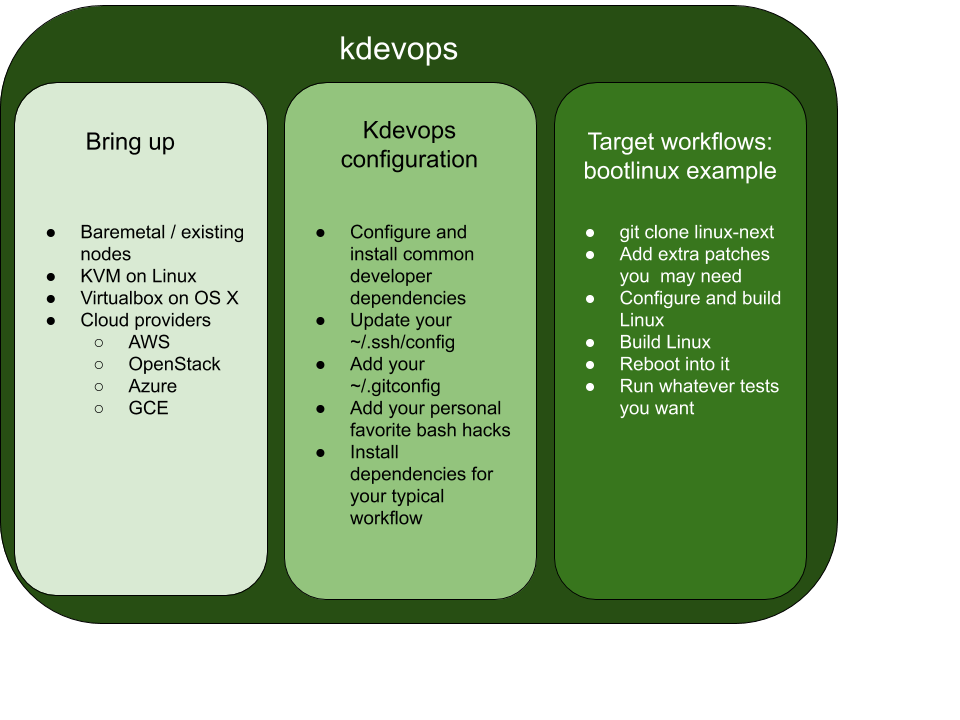kdevops
kdevops provides a devops environment for Linux kernel development and testing. It makes heavy use of local ansible roles and optionally lets you use vagrant or terraform. kdevops is Linux distribution agnostic, and also supports OS X. It aims at letting you configure these tools and bring up a set of nodes for Linux kernel development as fast as possible.
You can use this project as a template, or you can fork it for your own needs. Better yet, if you really have custom changes and you want to keep them private, this use is encouraged and supported, the best to do this however is for you to consider using kdevops as a git subtree.
Quick kdevops demos
To give you the idea of the power and goals behind kdevops we provide a few quick demos of what you can do below. More workflows will be added with time. There is documentation below on how to get started to add new workflows.
Start kernel hacking in just 4 commands
Configure kdevops to use bare metal, cloud or virtualization solution, pick your distribution of choise, enable the Linux kernel workflow, select target git tree, and get up and running on a freshly compiled Linux git tree in just 4 commands:
make menuconfigmakemake bringupmake linuxmake linux HOSTS="kdevops-xfs-crc kdevops-xfs-reflink"for example if you wanted to restrict running the above command only to the two hosts listed
Start running fstests in 2 commands
To test a kernel against fstests, for example, if you enable the fstests workflow you can just run:
make fstestsmake fstests-baseline
Start running blktests in 2 commands
To test a kernel against fstests, for example, if you enable the blktests workflow you can just run:
make blktestsmake blktests-baseline
Parts to kdevops
It is best to think about kdevops in phases of your desired target workflow. The first thing you need to do is get systems up. You either are going to use baremetal guests, use a cloud solution, or spawn virtualized guests.
The phases of use of kdevops can be split into:
- Bring up
- Make systems easily accessible, and install generic developer preferences
- Run defined workflows
kdevops documentation
Below is kdevops' recommended documentation reading.
- kdevops requirements
- kdevops' evolving make help
- kdevops configuration
- kdevops first run
- kdevops running make
- kdevops running make bringup
- kdevops example workflow: running make linux
- kdevops running make destroy
- kdevops make mrproper
kdevops kernel-ci support
kdevops supports its own kernel continous integration support, so to allow Linux developers and Linux distributions to keep track of issues present in any of supported kdevops workflows and be able to tell when new regressions are detected. Documentation for this follows:
Underneath the kdevops hood
Below are sections which get into technical details of how kdevops works.
- Why vagrant is used for virtualization
- A case for truncated files with loopback block devices
- Seeing more issues with loopback / truncated files setup
- adding a new workflow to kdevops
- kconfig integration
- Motivation behind kdevops
- Linux distribution support
- Overriding all ansible role options with one file
- kdevops vagrant support
- kdevops terraform support
- kdevops local ansible roles
- Tutorial on building your own custom vagrant boxes
License
This work is licensed under the copyleft-next-0.3.1, refer to the LICENSE file for details. Please stick to SPDX annotations for file license annotations. If a file has no SPDX annotation the copyleft-next-0.3.1 applies. We keep SPDX annotations with permissive licenses to ensure upstream projects we embraced under permissive licenses can benefit from our changes to their respective files. Likewise GPLv2 files are allowed as copyleft-next-0.3.1 is GPLv2 compatible.
